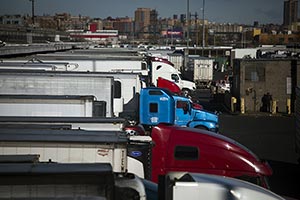Transportation for Urban Eating: High Demand, High Levels of Difficulty

WASHINGTON — Modern urban life presents special challenges for food transportation and distribution, including constant replenishment of stock to recipients who are often in challenging delivery locations.
New York just finished studying its intake and distribution of food, while Seattle is wrestling with the last 50 feet of delivery. Chicago needs cross-docking facilities and Wal-Mart Stores is adapting to business in urban areas, according to a Transportation Research Board session here Jan. 10.
After Superstorm Sandy walloped New York and New Jersey in the fall of 2012, a food shortage erupted throughout New York. Then Mayor Michael Bloomberg decided officials needed to know more about how more than 8.5 million mouths get fed on a daily basis.
Ryan White, an assistant vice president of the city’s Economic Development Corp., said the city has now completed the Five-Borough Food Flow study that Bloomberg ordered.
“We didn’t know how much food was consumed in the city, or where it went. We needed to do a deeper dive,” White said.
Among the findings, 19 billion pounds of food wends its way through the city each year, and 99% of the last-mile delivery is done with trucks.
More than half of the city’s food travels over four big bridges or through two major tunnels.
More than half of the city’s food starts its last-mile delivery within the five boroughs that also include the city’s 42,000 point-of-sale destinations.
Large supermarkets sell 23% of the city’s food, by volume, but account for only 2% of locations. Many New Yorkers shop at small neighborhood markets, bodegas and delicatessens.
Forty percent of the food is eaten in restaurants and cafes, the report found.
The city’s biggest food hub is the Hunts Point Terminal Market in the South Bronx with 1 million square feet of interior space that gets supplied daily with food from 49 states and 55 countries by truck, plane and boat.
Chicago has a problem matching the right truck for the right job and could benefit from more cross-docking, a University of Wisconsin researcher said.
Michelle Miller, associate director of the university’s Center for Integrated Agricultural Systems, said Wisconsin farmers send a lot of their food on, roughly, 200-mile journeys to Chicago and the process doesn’t always work well. Tractor-trailers need a place to unload just outside the city, she said, and have their loads transferred to medium-duty or Class 7 trucks that can ply city and suburban routes more easily.
She recommended Chicago copy the Ontario Food Terminal in Toronto “as a model we could use.” Miller said the provincial government created the terminal in 1954 to make it easier for Ontario farmers to feed people in metropolitan Toronto.
Wal-Mart rose to national prominence with 200,000-square-foot stores surrounded by massive parking lots in rural and suburban areas, but since 1998 the retail giant has been shrinking its footprint for new stores in urban areas.
Mark McGrath, an inbound logistics manager for Wal-Mart in the Mid-Atlantic, said the company made the change, “in response to consumer demand for convenience, as well as meeting consumer demand for low-cost groceries in urban areas and ‘food deserts.’ ”
Wal-Mart ranks No. 3 on the Transport Topics Top 100 list of the largest private carriers in North America.
Wal-Mart now operates in places such as Chicago, Richmond, Virginia, and Washington, D.C., running stores with 120,000 square feet or less.
McGrath’s division supplies a 4,100-square-foot store on the Virginia Commonwealth University campus that he calls, “The smallest Wal-Mart you’ll ever see.”
The urban stores use special equipment such as 28, 36 and 45-foot trailers and are often visited during limited hours at night.
The company also operates grab-and-go lockers for quick pickups and employs a staff of personal shoppers to assemble orders for customers who take possession in the store’s parking lots so they don’t have to leave their cars.
University of Washington researcher Barbara Ivanov said many upscale, technology-loving Seattle residents want fast, precise deliveries of packages, groceries and prepared foods. However, the last 50 feet from curb to lobby or apartment door is the most challenging part of the operation.
To work well, Ivanov said, the city, building owners and delivery people need to use a combination of alleys, curbside parking and loading docks.
She said a typical customer might be “someone who leaves work at 6 and gets home via transit at 7, it’s darned nice to have a food-delivery option.”

